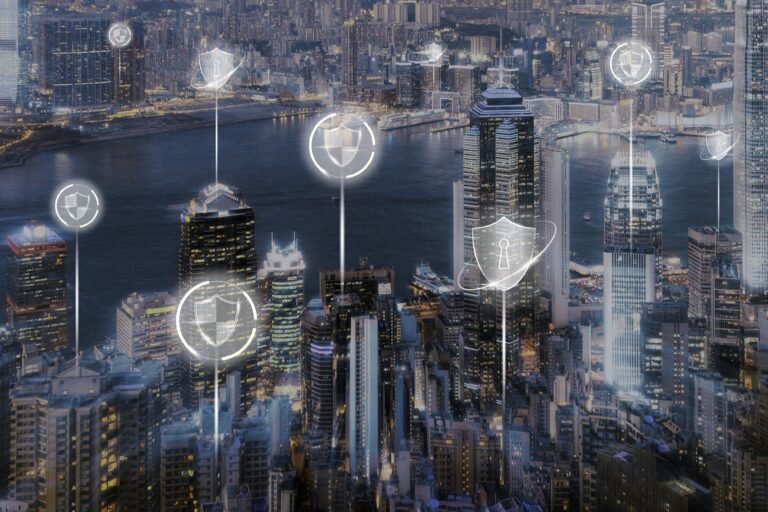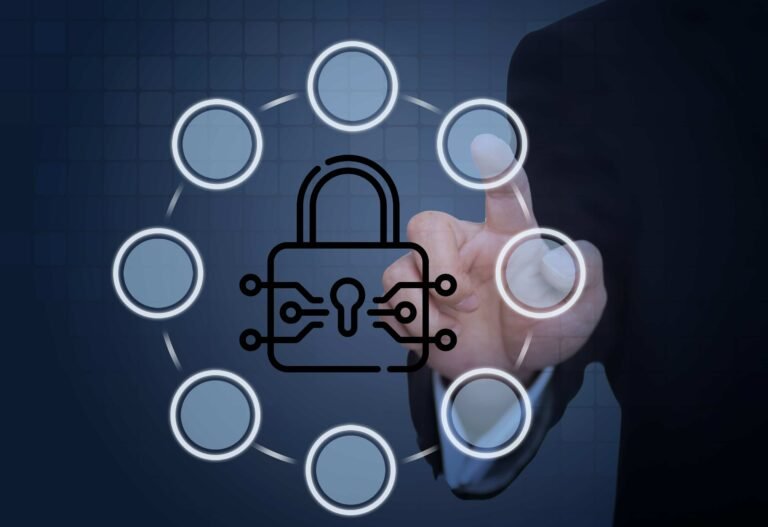Industrial Cybersecurity- Case Studies and Best Practices
In today’s digital world, “industrial cybersecurity” is like a superhero, keeping all the complex machines and networks safe in our modern factories and plants. Imagine factories buzzing with robots, power systems full of energy, and water plants running smoothly – all thanks to the watchful eye of cybersecurity. These places are very important for you because they keep our daily lives going. It’s like a big team where computer tech and heavy machinery work together perfectly. But, just like in any story, there are villains like cyber threats that try to mess things up.
We look at real stories where big companies faced serious online threats but came out stronger. These stories teach us important lessons on how to protect ourselves better. They show us the smart moves to make our systems tough against hackers. It’s like learning from past mistakes to build a stronger shield for the future. We’re going to explore how to keep our big industries safe from online dangers, breaking it down so it’s easy to understand. Let’s dive in and figure out how to defend our industrial giants from the hidden enemies of the online world.
Industrial Cybersecurity Risk
At the center of keeping our factories safe online is the idea of risk. Risk is tricky and can hide in the many connections of our factory systems. Think of a big factory where all the machines and computers are linked together. This creates many chances for hackers to hack the systems. The danger isn’t just someone breaking into the system; it’s about the chain reaction that can stop the whole factory, put people at risk, and cost a lot of money.
In the online world, dangers aren’t just hackers in dark rooms but also smart groups that can be working for countries or even people inside a company going rogue. They use bad software, ransom demands, and tricky emails to attack the systems that run our factories and keep things like electricity and water working. It’s a big deal because these systems are what keep our everyday needs met.
Getting to grips with the risks in keeping our factories safe online means looking closely to see where they might be weak. It’s about seeing how everything is connected today, and how a problem in one spot can cause trouble everywhere. But don’t worry, facing these risks means we can improve our defenses. We can build a tougher, more reliable online shield to keep our important factories safe from the digital dangers that might come our way.
What Makes Industrial Cybersecurity Different?
Going deeper into industrial cybersecurity, it’s important to see how it’s different from regular computer security. Imagine two different worlds: one is the fast-paced world of computer tech (IT) and the second one is the tough world of machines and factories (OT) that make things work in real life. They’re not just different in looks or what they do, but in their whole setup.
In the IT world, protecting information is everything. This includes things like personal details, money records, and business secrets. Everything changes fast here, with constant updates and the need to move quickly. Now, look at the OT world, which keeps our factories and physical work going. Here, the most important thing is keeping things running smoothly, reliably, and safely. These systems are built to last a long time, and any stop in work can cause big problems, like stopping production or creating safety risks.
This big difference creates special challenges for you us to keep factories safe online. In places like factories, you can’t just update and restart a system without thinking about how it might stop the work or mess up important services. Now that computer tech (IT) and factory tech (OT) are coming together, the risks from both sides mix, making cybersecurity more complicated. It’s like a careful dance, where keeping away digital dangers shouldn’t stop the machines from running smoothly. Getting this balance right is crucial for handling the tricky parts of keeping factories safe online, where the computer world and the real world of machines meet in a critical dance.
The differences between IT cybersecurity and industrial cybersecurity

differences between IT cybersecurity and industrial cybersecurity
Looking closely at the great world of cybersecurity, it’s clear it’s not just one big thing but more like a complex quilt with many different pieces, each showing a different side of keeping our digital world safe. The differences between regular computer security (IT) and factory security (industrial cybersecurity) are one part of this quilt, each with its own set of challenges and ways to deal with them.
IT security is all about keeping digital information safe. It focuses on making sure data is kept secret, accurate, and always available when needed. This world is fast-paced, always changing to fight off new types of cyber attacks. Here, staying safe often means updating software and systems quickly and being ready to change tactics at a moment’s notice.
Moving over to the world of factory cybersecurity, things change a lot. Now, we’re talking about the tech that runs machines in fields like making stuff, energy, and public services. The big deals here are keeping people safe, making sure systems are always up and running, and that they’re reliable. Even a short stop at work can cause big problems in the real world. This area often deals with very old systems that might have been working for many years, so updating them all the time isn’t doable.
As computer tech (IT) and factory tech (OT) start to mix in today’s factories, it’s getting harder to tell them apart, but it also makes it super clear how different they are. Keeping factories safe online means figuring out how to bring in the latest IT safety tricks without messing up the old, reliable factory systems. This tricky situation needs someone who gets both sides, building a safety plan that’s quick and smart like IT but also solid and steady like OT.
While IT cybersecurity focuses on keeping online data safe and secure from attackers, industrial cybersecurity looks at keeping physical factory operations running smoothly and safely. Even though they’re connected, the two areas need different plans and ways of thinking, showing how complicated cybersecurity is in our world where everything is linked together.
Creating effective policy for cybersecurity management
In the world of cybersecurity, making a good plan isn’t just about setting rules; it’s like putting together a dance where all the different parts of online safety work well together. This is super important in big industries, where keeping things safe isn’t just about computers, but also about the actual machines that make everything work.
To make a solid cybersecurity plan for these places, you need to understand how the digital and physical parts come together, and how computer tech (IT) and machine tech (OT) mix. It’s about understanding the different needs of these two areas – how IT needs to move fast to deal with threats, and how OT needs to keep things stable and secure.
The first step is to look into what could go wrong – looking at all the weak spots and dangers that could hit the industry. This isn’t just ticking boxes; it’s a deep look at everything from hackers outside to mistakes people inside might make. It’s about figuring out not only what could mess things up but also how we’d fix it if something did happen.
After figuring out the risks, the plan needs to lay out clear steps on how to stop problems before they start, how to spot them if they happen, and what to do about them. This means making rules for updating and fixing systems, even though it’s tricky in places where you can’t mess with how things run. It also means putting in strong systems to keep an eye on things, systems that can spot when something’s not right without getting confused by false alarms.
But a good plan isn’t just about the tech stuff. It also includes training people so they know how to spot and deal with security risks, making them a strong line of defense just like digital safeguards. It sets up clear ways to communicate, so when problems do happen, everyone can act fast and together to fix things quickly, keeping damage low and getting everything back to normal smoothly.
Making a solid cybersecurity plan for industries is like putting together a big music piece. Every step, every action, needs to be thought out to make sure the quick beats of computer security and the steady pace of machine safety work well together, creating a safe tune that protects not just our information but the core of our industrial world.
Safeguarding Operational Support

Safeguarding Operational Support
In the big picture of keeping our businesses safe online, protecting the systems that help everything run smoothly is super important. These systems are like the unsung heroes, making sure production keeps moving, energy gets to where it’s needed, and our water stays clean. Keeping them safe isn’t just about keeping data safe; it’s about making sure the heart of our industries keeps beating.
To keep these crucial systems safe, we need a defense that covers all bases, both the physical parts and the online parts. Think of it like a fortress with not just walls and towers but also a smart network of sensors and alarms. Each part is there to spot, stop, and fight off any threats. This is what it means to protect these support systems – building a defense that’s strong both online and in the real world.
At the center of this safety plan is dividing up the network into separate sections, making barriers that split up the different parts of the support systems. This isn’t just about putting up digital barriers; it’s about making sure that if one part gets hit, the whole system doesn’t go down with it. It’s like setting things up so that if one domino tips over, it doesn’t knock down the whole row, keeping each part strong even when there’s trouble.
On top of the cyber security stuff, keeping things secure in the real world is just as important. Getting into the places where the important systems need to be controlled, using things like fingerprint scans, keycards, and passwords so only the right people can get in. Watching over these places isn’t just about online stuff; it includes cameras and sensors to keep an eye on the actual spaces where these systems are.
Training and making everyone aware of how to keep things safe is a huge part of this plan. It makes sure everyone who works with these systems knows not just how to use the tools but also understands how to keep things safe. It’s about making a workplace where being careful and alert is part of everyone’s everyday job.
Keeping our industrial support systems safe online is like leading a big orchestra of safety, where every part and piece plays a role in creating a strong defense against all the dangers that threaten our factories and plants. It shows that in fighting off online threats, our best tool isn’t just the latest tech, but also our shared determination to guard the machines and systems that keep us moving forward.
How to manage cybersecurity risk through measurement
In the complex world of keeping our industries safe online, handling risk is more than just setting up digital walls; it’s about really getting the whole process. It’s like watching the back-and-forth of dangers and defenses and turning something hard to grasp into clear signs that show us what to do next. This way of figuring things out turns the fuzzy idea of risk into something we can actually act on, helping us stay ahead of new online dangers.
The key part of this strategy is using certain measures, like signposts and maps for online safety, to help us navigate through unknown digital areas. These measures show us how well our safety efforts are working, like how quickly we spot and deal with problems, how often our systems are running smoothly, or how good we are at stopping fake email scams.
On the other hand, we have alerts that let us know about possible dangers before they turn into bigger problems. These can be things like how many systems haven’t been updated or how often hackers are trying to break in. By keeping an eye on these alerts, companies can understand their risk better and change their safety plans to deal with new threats as they come up.
But keeping track of safety isn’t just about counting things; it’s about always getting better. This means regularly checking how strong our safety measures are and finding ways to make them even better. It’s a process of testing, learning, and changing, making sure our safety efforts keep up with new threats.
Also, comparing our safety practices to well-known standards, like the NIST Cybersecurity Framework or ISO 27001, helps us see how well we’re doing compared to others. It’s about understanding where we stand in the bigger picture, learning from others, and aiming to be the best.
Handling online safety risks by keeping track of things is like using the stars to find your way; it needs accuracy, the ability to change, and a deep understanding of the situation. By making the hard-to-measure things measurable, companies can plan their online safety moves with sureness, making sure every step is thought out and every action is planned to keep the essential workings of our industries safe.
What we can learn from the safety culture

What we can learn from the safety culture
In the world of keeping factories safe online, there’s a lot to learn from the traditional safety practices that have been the foundation of industrial work for years. These practices, developed and perfected over time, offer valuable insights for online safety, especially in today’s industries where the digital and physical worlds meet.
The key idea in this safety culture is thinking ahead and being ready for problems before they even happen. It’s about not just dealing with issues as they come but actively trying to stop them in the first place. This forward-thinking approach is super important in online security too, where spotting potential dangers early can stop big problems and keep everything running smoothly.
Another key part of safety culture is always learning and getting better. In factories and industries, every small problem is seen as a chance to learn something new and make things stronger. This idea is very important for keeping things secure online too, where dangers change quickly. By always learning, companies can keep up with new dangers and make sure their defenses are up to date.
Being open and clear in communication is also crucial to a safety culture. It means making sure everyone knows about the risks and any problems that happen. This openness helps everyone feel like they’re part of keeping the place safe, making it easier for people to watch out for dangers and speak up if they see something wrong. In the online safety world, it’s important to have an environment where people can talk about threats and problems without being scared. This helps make sure everyone is on the lookout for online dangers, and that any issues are dealt with right away.
The safety culture also shows us how important it is for everyone to take charge and feel empowered. In places like factories, every worker, no matter their job, learns how to spot and deal with safety issues. This way, keeping secure is part of everyone’s job every day, not just something for a few people to worry about. In the online security world, teaching everyone to notice and handle online dangers can make a company’s defenses stronger. It turns all employees into active players in keeping things safe, instead of just watching from the sidelines.
Taking tips from the safety culture gives us a guide on how to make online safety a natural part of how industries work. It’s about using the lessons learned from the past to deal with the online challenges we face now. This way, as our industries grow and change, they stay not only efficient and productive but also safe and tough against the online dangers of today.
Conclusion
In our deep dive into keeping the industry cybersecurity, we’ve gone from figuring out the special risks to putting good plans in place, making sure everything that keeps the industry running is protected, and you learning from old safety tricks. This journey has shown us the big challenges in keeping our industrial world safe and has shone a light on the best ways to move forward, using smart tips and valuable lessons. Standing at the crossroads of the digital and physical worlds, stories of toughness, staying ahead of problems, and everyone pitching in show us the way. They remind us that when we’re up against constantly changing online dangers, our best shield is our ability to change, learn, and stick together. The wisdom we’ve gathered from every part of this conversation lights the way for our industries, helping them not just get through the rough seas of online safety but also do well, making sure that as we keep coming up with new things, we stay safe too.
FAQs
1. Why is industrial cybersecurity important?
Industrial cybersecurity is crucial as cyber threats can disrupt operations, compromise safety, and lead to substantial financial losses in industrial sectors.
2. How can industries prevent cybersecurity breaches?
Implementing robust security protocols, conducting regular risk assessments, and providing comprehensive employee training are key preventive measures.
3. What are some notable cybersecurity frameworks for industries?
Common cybersecurity frameworks include the NIST Cybersecurity Framework and IEC 62443, providing structured guidelines for securing industrial systems.
4. How does collaboration help combat cyber threats in industries?
Collaboration fosters the exchange of threat intelligence and best practices, strengthening collective resilience against evolving cyber risks.
5. What should industries anticipate regarding future trends in cybersecurity?
Emerging technologies like AI, IoT, and cloud computing present both opportunities and challenges, requiring proactive strategies to address new threats.








11 Comments